Giorgi Vashadze: “Exports to Russia constitute USD 600 million whilst imports from Russia amount to USD 1.8 billion.”
Verdict: FactCheck concludes that Giorgi Vashadze’s statement is MOSTLY TRUE.
Exports to Russia increased by 2.2%, reaching USD 657 million whilst imports from Russia decreased by 5% to USD 1.750 billion in 2023. The negative trade balance constituted 45% with imports exceeding exports by 2.7 times.
Russia is not the only country with which Georgia has a negative trade balance as this is also true for most of Georgia’s trade partners. Imports have consistently surpassed exports since 1995. Georgia exported goods worth USD 54.3 billion whilst imports totalled USD 157 billion (2.9-fold higher) from 1995 to 2023. Consequently, the negative trade balance amounted to 49% over this period.
Whilst the growth rate of exports to Russia has declined, exports to other countries have increased, resulting in a reduced share of Russia in total exports. However, Russia has become Georgia’s top market for domestic exports following its invasion of Ukraine. Specifically, Russia accounts for 60% of Georgia’s wine export market, 45% of its mineral water exports and over 80% of its fruit exports.
Georgia is heavily dependent on Russia for flour and wheat imports. Additionally, the share of energy imports from Russia, particularly natural gas and oil products, has also increased.
Although the figures reported by the MP are close approximations of the official data, it is important to note that Georgia has a negative trade balance not only with Russia but globally. Furthermore, Russia has moved to the first place in domestic exports. Considering the numerical accuracy and a slight alteration of the context, FactCheck concludes that Giorgi Vashadze’s statement is MOSTLY TRUE.
Analysis
One of the United National Movement political party’s leaders, Giorgi Vashadze, met with farmers in Kareli and stated (from 0:24): “Exports to Russia constitute USD 600 million whilst imports from Russia amount to USD 1.8 billion.”
After declaring independence, despite political tensions, Russia became the leading partner in exports for Georgia. Russia’s share in exports averaged 23% from 1995 to 2005 before the embargo was imposed. However, it is important to note that reliance on Russia was already exhibiting a downward tendency even before the embargo and the Rose Revolution. Particularly, Russia’s share in Georgia’s exports was 31% in 1995 but had decreased to 18% by 2003. Increased exports to other countries contributed to the aforementioned reduction.
Moscow imposed an embargo on Georgia’s primary export products, namely wine and mineral waters, resulting in Russia’s share dropping to 8%. Russia was surpassed by two neighbouring countries – Turkey and Azerbaijan, whilst Armenia came close. Russia’s share continued to decline in the following years reaching its historic minimum of 1.7% in 2011.
Russia’s share in exports averaged 3% during the embargo period (2006-2012), ranking the lowest amongst neighbouring countries. In addition to the embargo, the reduction in Russia’s share in exports was further influenced by a rise of vehicle re-exports as vehicle re-exports to other countries increased and further diminished Russia’s share in Georgia’s total exports.
Although the Russian market reopened following the change in the government, Georgia’s reliance on Russia has not returned to its pre-embargo levels.
Graph 1: Exports to Russia
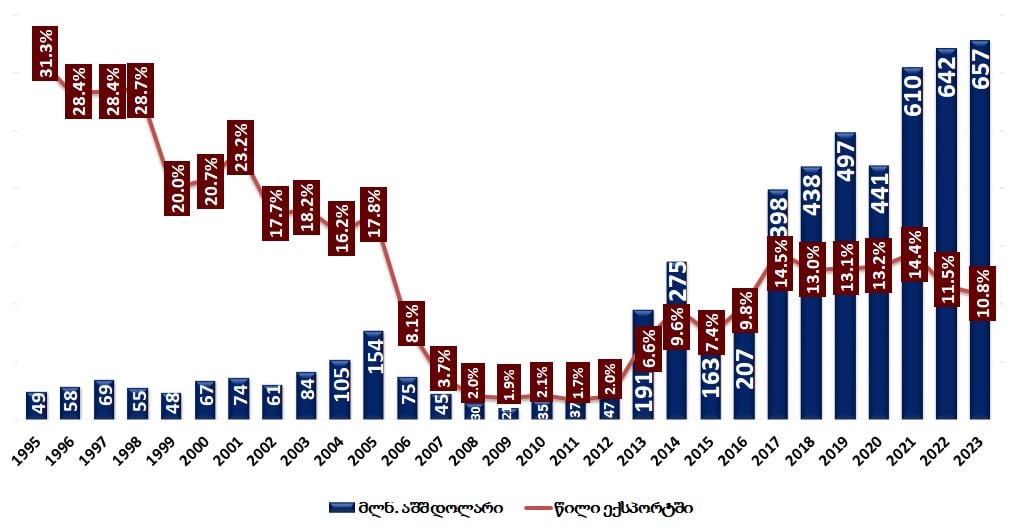
Source: National Statistics Office of Georgia
Despite Russia consistently ranking first in exports prior to the embargo, it was then surpassed by Azerbaijan. Furthermore, China, Armenia, Kazakhstan and Kyrgyzstan also exceeded Russia’s shares in certain years.
Whilst exports to Russia increased in monetary value after Russia’s invasion of Ukraine, its share still decreased, as the growth rate of exports to other countries was higher, influenced by re-exports.
It is important to highlight domestic export (exports without re-exports) statistics in addition to total export data. The aforementioned figures are available from 2014. Russia has ranked first in domestic exports from 2014 to 2023, excluding 2015 and 2020-2022 when Turkey and China, respectively, exceeded Russia’s figures. Despite this, Russia maintaining its leading position in overall domestic export statistics.
Graph 2: Domestic Exports to Russia

Source: National Statistics Office of Georgia
What does Georgia sell to Russia? Wine was the primary export product in 2023 whilst alcoholic beverages ranked second and light vehicles ranked third. Furthermore, other products in the top ten were: fruit (including several fruit groups, such as apricots, cherries, peaches, plums and sloes, apples, pears and quinces), mineral and aerated waters. Whilst ferroalloys led the list of export products in 2021, its share declined to 73% in 2023. Furthermore, light vehicles can no longer be found in the data for 2024 as merely three cars worth USD 21 thousand were sold over the previous seven months.
Graph 3: Exports to Russia (USD Million)
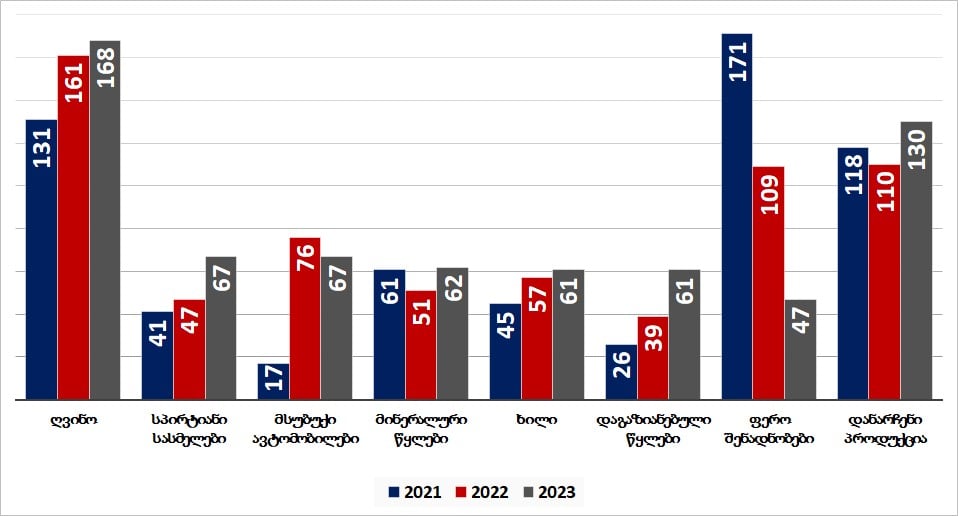
Source: National Statistics Office of Georgia
Russia’s share in exports of certain products, especially in domestic exports, is significantly higher. Every two out of three exported bottles of wine were sold to Russia in 2021-2023. Particularly, Russia’s share in monetary value was 61% and in numerical terms – 66%. These figures have increased to 70% and 74%, respectively, in the first seven months of 2024. Notably, the increase in wine exports to Russia was likely driven by the increase in excise tax from May, leading the Russian importers to increase their stocks beforehand.
Russia’s share in Georgian wine exports amounted to 59% in monetary and 62% in numerical terms from 2013 to August 2024 after the Russian market reopened for the Georgian produce. Additionally, export prices in Russia have been lower as compared to other countries worldwide since 2014. For instance, whilst the export price for one litre of Georgian wine was USD 2.70 in Russia, it was USD 3.33 in other countries.
Currently, more Georgian wine is sold globally (excluding Russia from the current data altogether) as compared to the volume of wine exported, including Russia, in the period before the embargo was imposed. However, Russia remains the leading export market for Georgian wine to this day due to issues related to its global recognition and quality.
Graph 4: Wine Exports to Russia
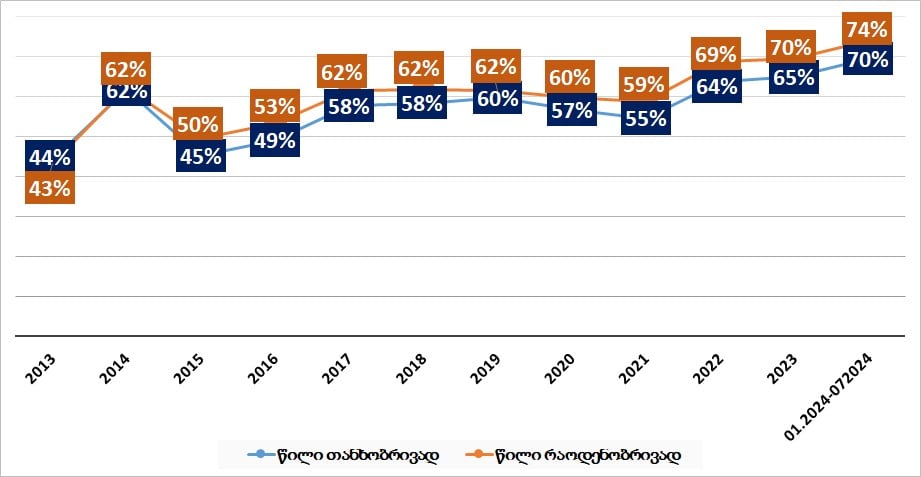
Source: National Statistics Office of Georgia
Although Russia accounts for a lower share of the 45% for exported Georgian mineral waters, this figure is still notably high. Furthermore, Russia’s share in exports of Georgian fruit groups exceeds 80%.
A high degree of reliance on a market for specific products can be risky not just for the occupying country but also for partner countries. For instance, light vehicle exports to Azerbaijan dropped from USD 400 million to USD 65 million from 2013 to 2015 when the country implemented EURO 5 standards for car imports. Exports of copper ores to China decreased from USD 583 million to USD 179 million in 2022-2023 which then led to a decrease in overall exports from USD 737 million to USD 311 million. In addition to economic aspects, risks in the case of Russia are further amplified by political factors.
Georgia has a negative trade balance with Russia and the majority of countries worldwide. Total exports amounted to USD 54 billion and imports constituted USD 157 billion whilst the negative trade balance was 49% from 1995 to 2023.
Exports to Russia totalled USD 5.6 billion and imports amounted to USD 15.3 billion whilst the negative trade balance with the country was 46% over the aforementioned period. It is worth noting that although the negative trade balance reached 83% under the embargo from 2006 to 2012, it subsequently decreased to 41% in the period between 2013 and 2023.
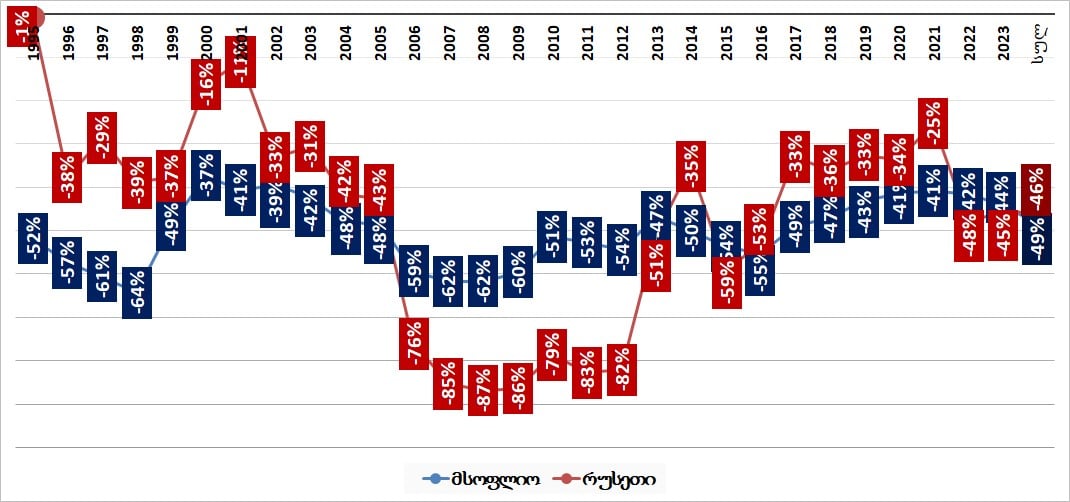
Source: National Statistics Office of Georgia
Analysing the period after the war began, Georgia’s total negative trade balance was 43% whereas the balance with Russia amounted to 47%, primarily driven by increased imports, particularly for oil products from Russia. The slight increase in the price for Russian oil and oil products was profitable for Georgian importers.
What do we purchase from Russia? Oil products rank first – fuel and diesel whilst natural gas ranks second. Finally, flour and wheat combined take the third position (however, they are listed separately in import data).
Graph 6: Imports from Russia (USD Million)
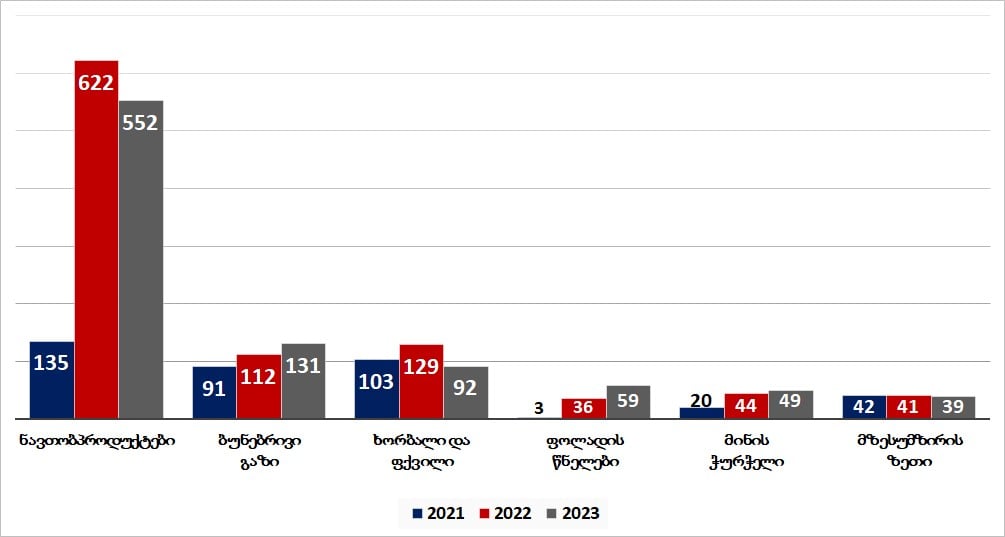
Source: National Statistics Office of Georgia
Russia accounts for nearly 100% of flour and wheat imports and over 80% of sunflower oil imports in Georgia. Notably, Russia’s share of oil product imports was 16% in 2021, tripling in value in 2022 and 2023 (47%).
Russia’s share in the Georgian natural gas market averaged 14% in monetary terms from 2013 to 2020. This figure then increased to 27% from 2021 to 2023 and reached 44% in January-July 2024. Moreover, Russia’s share by volume was 8% between 2013 and 2019, increasing to 19% from 2021 to 2024 and reaching 30% in January-July 2024.
Georgia purchases gas from two countries: Azerbaijan and Russia. Although Azerbaijani gas is overall cheaper, the market is divided into multiple sectors. Georgia receives 5% of the gas transported through the South Pipeline (Shah-Deniz Pipeline) at a special rate. Furthermore, there are subsidies for the so-called ‘social gas’ used for residential and heating purposes. However, these benefits do not include commercial gas. The exact rates for gas pricing are confidential, potentially due to a lower price for commercial Russian gas as compared to commercial Azerbaijani gas, which explains the rise in the demand for Russian gas.
The statement that exports to Russia amount to USD 600 million whilst imports total USD 1.8 billion is statistically accurate. Specifically, Georgia exported products worth USD 657 million to Russia and purchased goods totalling USD 1.750 billion from Russia. However, it is important to note several key points. Georgia’s trade balance has consistently been negative since its independence with the total deficit being approximately equal to the deficit with Russia. Additionally, Russia has moved to the first position in domestic exports. Furthermore, reliance on Russia for energy resources and consumption goods is also high.
Considering the numerical accuracy and a slight alteration of the context, FactCheck concludes that Giorgi Vashadze’s statement is MOSTLY TRUE.








